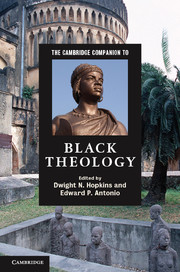Book contents
- Frontmatter
- Part I Introduction
- Part II Themes in black theology
- 6 God
- 7 Jesus in black theology: the ancient ancestor visits
- 8 Black theology and the Holy Spirit
- 9 Black theology and human purpose
- 10 Theology's great sin: silence in the face of white supremacy
- 11 Theodicy: “De Lawd knowed how it was.” Black theology and black suffering
- 12 Black theology and the Bible
- 13 Protestant ecclesiology
- 14 Roman Catholic ecclesiology
- 15 Dignity and destiny: black reflections on eschatology
- Part III Global expressions of black theology
- Further reading
- Index
- Other titles in the series
14 - Roman Catholic ecclesiology
from Part II - Themes in black theology
Published online by Cambridge University Press: 28 September 2012
- Frontmatter
- Part I Introduction
- Part II Themes in black theology
- 6 God
- 7 Jesus in black theology: the ancient ancestor visits
- 8 Black theology and the Holy Spirit
- 9 Black theology and human purpose
- 10 Theology's great sin: silence in the face of white supremacy
- 11 Theodicy: “De Lawd knowed how it was.” Black theology and black suffering
- 12 Black theology and the Bible
- 13 Protestant ecclesiology
- 14 Roman Catholic ecclesiology
- 15 Dignity and destiny: black reflections on eschatology
- Part III Global expressions of black theology
- Further reading
- Index
- Other titles in the series
Summary
In his commentary on the Song of Songs, Origen spoke of the church as a black woman. One of the first Church Fathers, Origen (c. 184–c. 253), born in Alexandria, was a teacher in the catechetical school, a theologian, biblical scholar, and, later in life, a priest. He wrote a commentary on almost all of the books of the Old Testament and on some of those that would be found in the New Testament. Like most early church writers, Origen moved from the literal meaning of the text to the allegorical meaning of the scriptural passage. When writing on the Song of Songs, Origen saw this text as the love song of Solomon and the Queen of Sheba (Ethiopia). Origen saw Solomon as Christ and the Queen of Sheba as the Church. It is she who in the first chapter of the Song of Songs says, “I am black and beautiful, O daughters of Jerusalem” (Song of Songs 1:5, Septuagint version). Origen wrote:
This queen came, then, and, in fulfillment of her type, the Church comes also from the Gentiles to hear the wisdom of the true Solomon, and the true Peace-Lover, Our Lord Jesus Christ.
He lists the black figures of the Old Testament, all of whom in some way are examples of the Church: “Now … since we are on the subject of the Church that comes of the Gentiles and calls herself black and yet beautiful.” He mentions the Ethiopian woman who became the wife of Moses, and he writes “Moses himself was never so highly praised by God as on this occasion when he took the Ethiopian wife.” In the same passage, Origen refers to Ebed-melech the Kushite who saved the life of Jeremiah by drawing him up from the abandoned cistern where he had been lowered into the miry mud and left to die. For Origen, not only the Queen of Sheba, black and beautiful, but also the wife of Moses and Ebed-Melech the Kushite, protector of the prophet – all of these are figures of the Church of the Gentiles.
- Type
- Chapter
- Information
- The Cambridge Companion to Black Theology , pp. 198 - 210Publisher: Cambridge University PressPrint publication year: 2012



